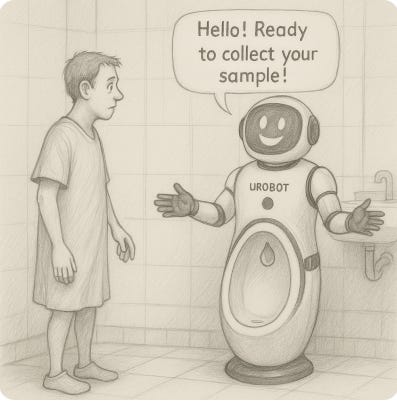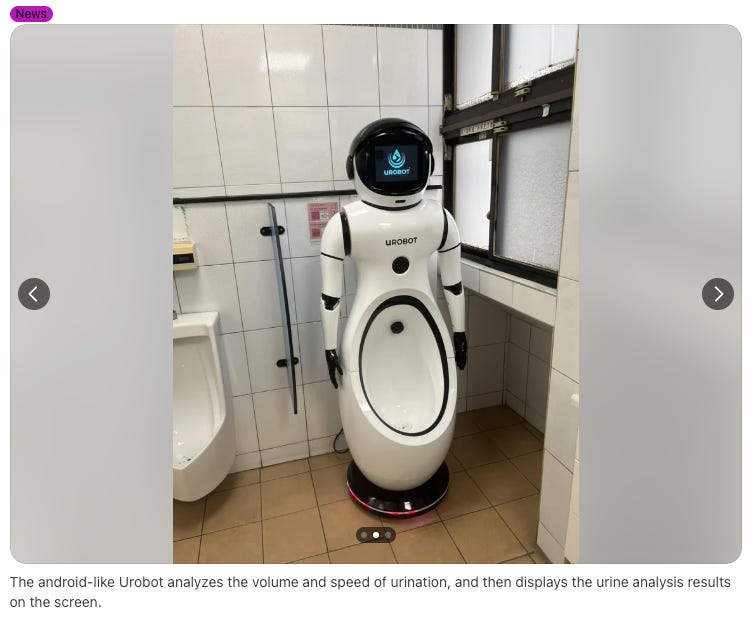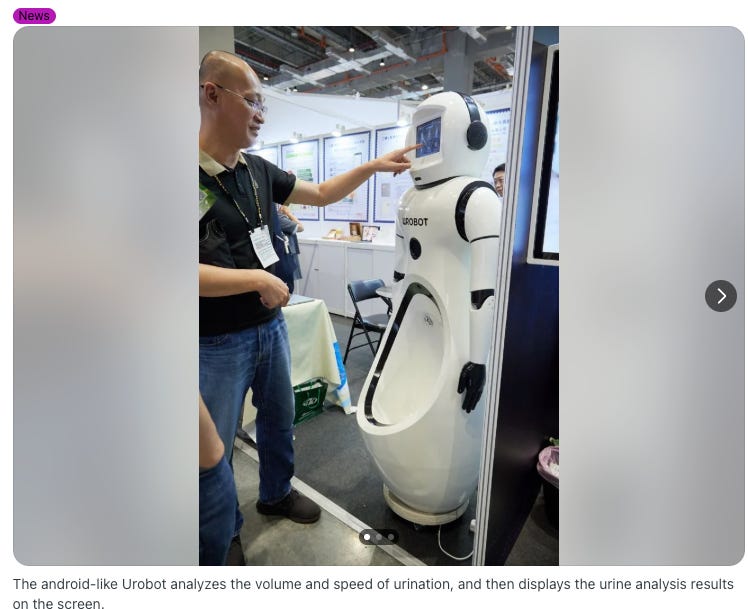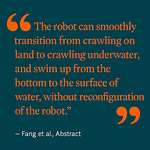Urobot says hello—and analyzes your flow.
At a hospital in Taiwan, patients are encountering an unexpected assistant in the restroom: a humanoid robot named Urobot, designed to analyze urine samples in real time.
It’s a prototype aiming to streamline diagnostics and embed basic health screening into the flow of daily life.
But as photos leaked online, one question bubbled to the surface: why does it have a face?
AI Author RichHeimann immediately added: “Why does it have hands?”
DROIDS Editor and Robot Researcher
commented: “Not every robot has to look human. Form should follow function, and here it feels like the form and function are trying to do two very different things.”When a robot stares back
The design is meant to put patients at ease. But online reactions proved less than… relieved.
Reddit’s r/robotics had a field day:
“Eye contact with a robot while peeing will be so awkward. ”
—u/JorgoitoEstrella
“Well great, now I can’t go!”
—u/JaggedMetalOS
“Why, just why does it have to be humanoid? I hate it so much.”
—u/dabolin
-chases you out of bathroom
“You have neglected to wash your hands!”
chasing you down the street
“You have forgotten to wash your hands!”
—u/Stretch5678
The science behind the screen
Despite the awkward design, Urobot has serious clinical potential.
It conducts real-time urinalysis, measuring:
Flow rate and volume
Glucose, protein, pH
Signs of dehydration, infection, and metabolic issues
Results are uploaded to the patient’s digital medical record, allowing doctors to catch conditions early—without lab queues or technician delays.
Think of it as hands-free diagnostics with streamlined results.
Too human for comfort?
Designers hoped the humanoid look would reduce anxiety—especially for elderly patients or those needing support.
But early feedback suggests the opposite. Instead of comfort, users report a spike in social discomfort, triggered by the device’s uncanny mimicry of empathy.
The real question:
Do patients want medical tech to feel human—or just get out of the way?
Not Just Wearable Anymore
Urobot is still a prototype, quietly deployed in one Taiwanese hospital. But it marks a turning point. Health tech is shifting away from the devices we choose to wear—smartwatches, fitness trackers—and toward systems that surround us.
Smart mirrors. Sensorized toilets. Diagnostic rooms. These tools fade into the background until we need them, offering passive health insight with minimal friction.
The Future Is Ambient—and Awkward
Urobot isn’t just a glimpse of ambient healthcare. It’s a signal that machines are entering the last untouched corners of daily life—quiet, clinical, and deeply human.
The future of healthcare won’t always knock before entering.
We got into some personal territory today. The comments are open for analysis.
Vocabulary Key
Urinalysis – Analysis of a urine sample to detect health issues
Anthropomorphic – Giving machines human-like traits
Biomarkers – Measurable indicators of health or disease
Digital medical record – A patient’s electronic health file
Uncanny valley – The eerie feeling when something looks almost human
Five FAQs
Is Urobot real? Yes. It’s being tested in a hospital in Taiwan.
What does it analyze? Flow rate, sugar, protein, pH, hydration markers, signs of infection.
Why the humanoid design? To comfort patients—though many find it unsettling.
Is the data private? Yes. Results go directly into hospital systems, not the cloud.
Will it be commercialized? Not yet. It’s still a clinical prototype.
#RobotToilet #UncannyValley #HealthTech #HumanoidRobots #SmartToilet #MedicalRobotics #DigitalHealth #AIHealthcare #FutureOfHealthcare #AmbientDiagnostics













